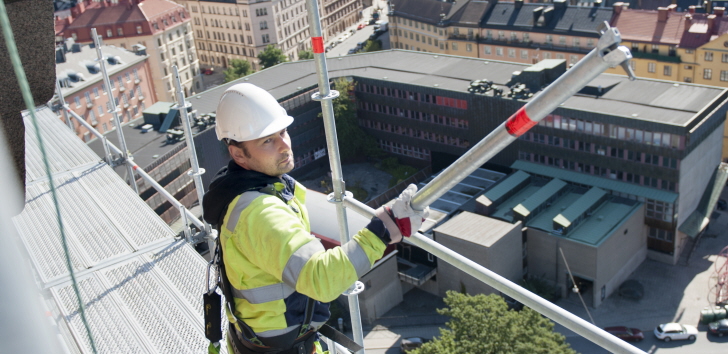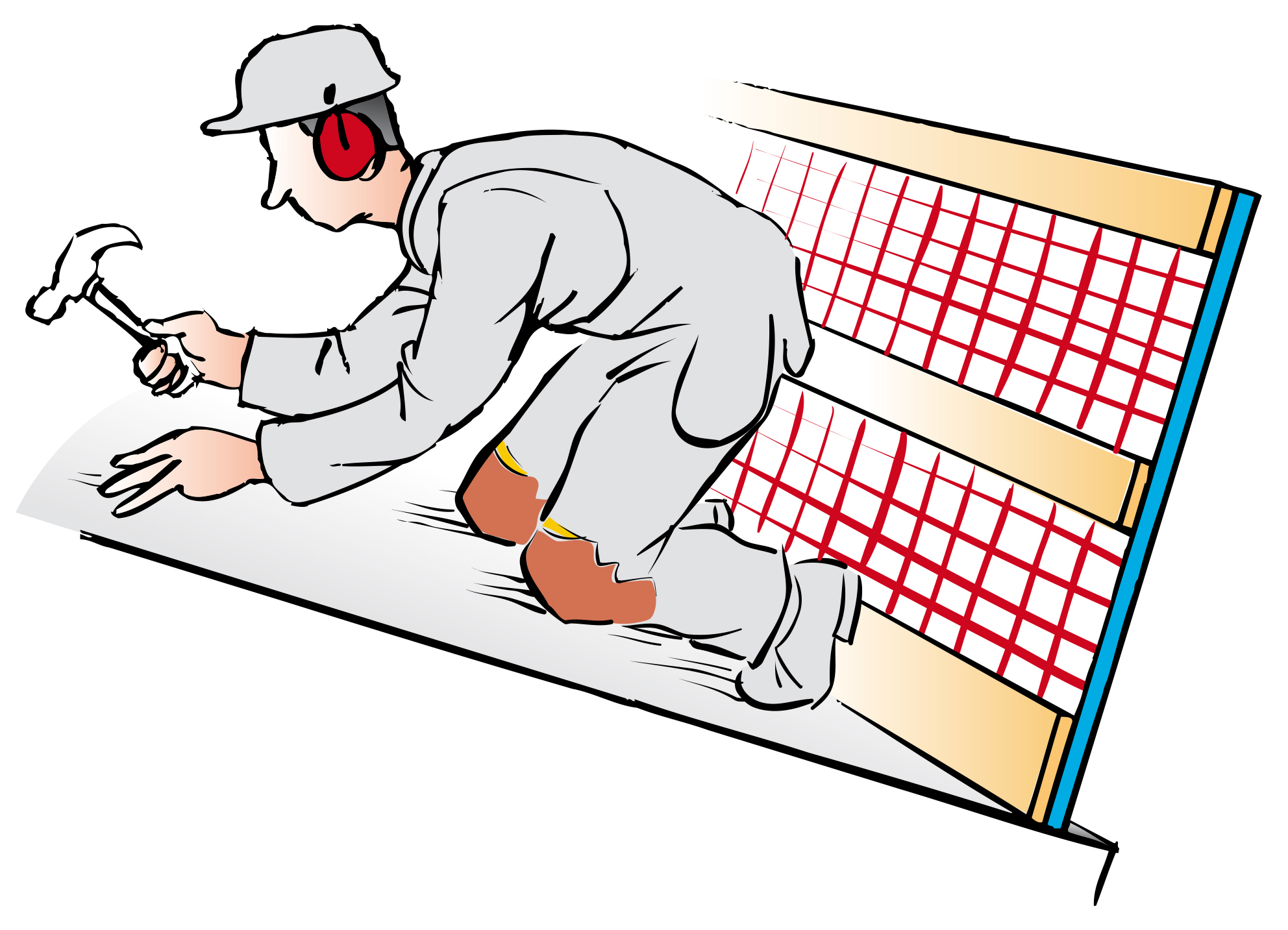Work that is carried out at heights
Falling is one of the most common causes of fatal accidents and serious injuries within the construction industry. That is why you must prevent risks of falling from height. You are also taking the risk to get a sanction fee if someone performs building or civil engineering work without any fall protection, on a height of two metres or more.

Risks of falls from height
Work where there is a risk of falling should always be assessed, regardless of the height someone can fall from. If there is a risk of falling two metres or more, a Work Environment Plan is required. The plan has to include a description of the measures in order to prevent the risk of falling from a height of two metres or more.
Examples of where there are risks of falls from a height:
- roof work
- facade work
- ladder work
- holes in, for example, the floor structure
- installation of prefabricated structures
- edges of excavations
- rockwork.
Protect yourself against falls from height (ADI 703), brochure
Who is responsible for what within building and construction? (ADI 704 Eng), brochure
Choose collective safety devices firsthand
With risks of falls from height, you should firstly use collective safety devices, that means safety devices that protect several persons from the risk of falling. If that is not possible, one should use personal fall protection equipment.

Fall protection rails
Guardrails should be strong and sufficiently high (at least one metre). They should be fixed so that they prevent falls over, through, or under the rail. The guardrail needs to consist of at least three transverse rails that are called the baseboard or toeboard, intermediate rail and toprail or principal rail, or have a corresponding safety construction that hinders falls from height.
The baseboard or toeboard should normally be about 0.15 metres high, the intermediate rail should be placed in the middle, and the toprail at the top edge of the guardrail. If there are loose objects that could fall through the guardrail, it should be covered. For surfaces that are not level or low-pitched, the rails need to be constructed in another way (closer together between the railing detail).
Sometimes the guardrail need to be higher than 1 metre, such as when the work is carried out on a steep roof. If the guardrail is permanent and included in the ordinary equipment of the building, it is often higher and can also lack a baseboard.
There are no exact requirements about how the guardrail should be dimensioned in order to be strong in our regulations. There is, on the other hand, a voluntary European standard for temporary guardrail systems (SS-EN 13374:2013), according to which many manufacturers have chosen to design their rails. A guardrail designed according to a standard also gives the user support during the choice of product.
When one uses timber in guardrails, it is important to choose the correct type. One must always use construction timber (or equivalent), and it is normally recommended that one chooses so-called construction timber in at least class C16, according to SS-EN 338:2009, in order to have sufficient strength. Often a higher strength class is necessary.
If a guardrail is not mounted along, for example, the entire roof, but only where the work is being carried out, it is important that it goes sufficiently far outside the actual working area in order to be able to really catch a person who falls. This means that the width of the guardrail needs to be significantly wider than the width of the working area, so that one is sure that it will catch someone who falls. A rule of thumb is that the width of the guardrail should be: width of working area + two x (distance between guard rail/toeboard and ’vertically’ up to the working area). "L".
Building and civil engineering work (AFS 1999:3Eng), provisions
Guardrails should always be checked before they start to be used, and during the time they are used.
Scaffolds
Read about what applies when working with scaffolds.
Mobile or fixed work platforms
Here you can read more about the requirements when using platforms such as scissor lifts for work on height.
Use of lifting devices and lifting accessories
Protective covering
Protective covering is used to cover a hole or other type of cavity where there is a risk of stepping or falling into it. This protective covering must always be strong, stable and in place. It should be clearly marked so that it cannot be misunderstood. It must be able to stand up to the physical loads to which it can be subjected.
Safety net
To use a safety net can be a suitable working method during certain types of work with risks of falls, such as hall construction. Before one chooses to use a safety net, one must thoroughly investigate that conditions are suitable for nets, by checking the external prerequisites.
The construction of the safety net must, in all situations, guarantee that it catches a falling person safely without other risks, such as falling out, falling between the nets, or hitting into something below the net.
This method places very high demands that those who use it have specific knowledge about the mounting and checking of safety nets. A safety net is ’fresh goods’ that demands specifically documented checks of the fibres and so on. Mounting a safety net demands, in addition, that there are suitable and strong attachment points.
Heavy construction, for example a prefabricated element, is often prepared for the attachment of a safety net when it is constructed, and before it is sent to the building site. The net must be able to be simply fixed into the attachment points at the building site, with the help of the use of another safe collective working method, such as via a hoist.
Low temperatures mean that safety nets cannot always be used because the net can become brittle.
In summary, safety nets demand that at least the following prerequisites exist:
- knowledgeable staff that can install and check the net during the entire job
- suitable height conditions so that the tension of the net can be maintained
- safety distance to the work taking place underneath the net
- the fall height to the net is small and below the demands in the standard
- suitable and strong attachment points for the net
- the climate is suitable for the use of safety nets
- instructions and directions for installation and inspection (for example, tensile testing of fibres, date marking and so on) at the construction site.
There is a voluntary European standard with safety requirements and test methods, as well as safety requirements during installation of safety nets, called SS-EN-1263. The standard is normally suitable to follow if net is to be used.
Personal fall protection equipment
Personal fall protection equipment can only be used in exceptional cases if it is not possible to use collective protection, or where the time to put these devices in place takes significantly longer than the time it takes to carry out the actual work.
Remember that the time does not just mean, for example, specific work on a roof, but all the work that needs to be conducted there. When personal fall protection equipment is used, it is important that the equipment is adapted to the work and the employee. A strong attachment point that fulfils applicable requirements must exist.
Work with risks of falls from height is normally inappropriate to carry out as solo work and if you use personal fall protection equipment, a plan must always be in place for rescue.
Consider that you must, at least, fulfil the minimum conditions in 60 a and 92 a §§ in order to avoid sanction fees during building and civil engineering work. The regulations mean that you must often supplement your measures by using personal fall protection equipment. Even a transfer along a ladder with back protection or along a roof jetty requires that you use personal fall protection equipment.
Work from a ladder must, if possible, be avoided and can only be used during short, isolated work where one cannot choose other, better alternatives.
Work with risks of falling from height should always be risk-assessed and described with how they should be prevented, among other things, in the work environment plan. If there are risks of falls from height of two metres or more, there must always be a work environment plan.
Sanctions within construction
Since there are several dangerous risks in construction, you can get a sanction fee when performing building or civil engineering work without following certain provisions.
Building and civil engineering work, (AFS1999:3Eng), provisions

Use of Personal Protective Equipment (AFS 2001:3Eng), provisions

Last updated 2024-01-24
